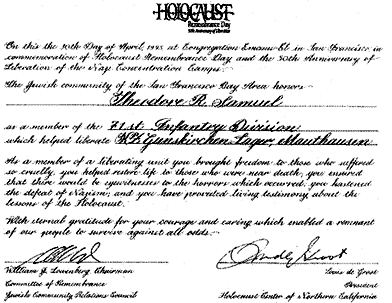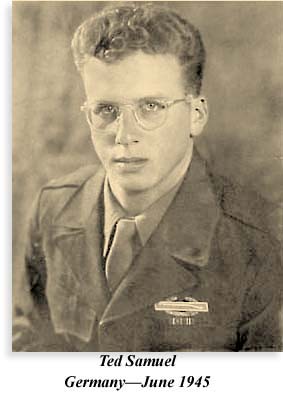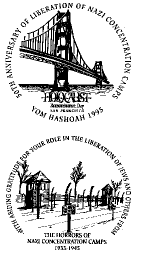|
|||||||||||||||||||
This letter was donated to the Museum by Theodore R. “Ted” Samuel, a retired San Francisco school teacher, and former general manager of NPR- Holocaust Remembrance Day, 1995, was one of the most moving events of my life.
First of all, the Temple is an unbelievable structure, constructed in the Moorish style in 1925, with an inner courtyard that in itself is large and architecturally very attractive, where we registered and were served wine and hors d’oeuvres. We even saw one ex-G.I. who was able to fit into his Eisenhower jacket (with a 71st Division patch)! Then we proceeded to a large downstairs hall, where we were served a delicious lunch. Two of the men at our table were also from the 71st Division. Our youngest daughter, Shari, and her boyfriend, also joined us. At lunch, there was some short greetings. The female Rabbi told us her father had died in battle in Europe during the war, and asked if, by chance, anyone knew him. No one did. Then we proceeded into the main sanctuary, which has to be one of the most beautiful temples in the world. The newly installed east and west stained-glass windows are stunningly beautiful! The sanctuary holds over 2000 people, and almost every seat was taken as the public-at-large was also invited. We ex-G.I.’s sat together in seats with our name tags. I sat next to the son of our commanding officer, the late Willard G. Wyman. I met a couple of African Americans, who were part of an all-Black tank corps attached to the 71st about a month before the end of the European war.
Our hosts also handed out
beautifully- The first part of the program was designed to memorialize and honor those G.I.’s and camp victims who died during the war years and in the Holocaust. It included a candle lighting by survivors, and a prayer for the dead. It was a very moving experience. The second part emphasized the G.I. liberators. This part included a pair of talks by a couple who where the guest speakers. The man was of German birth who escaped to America in 1937. A few years later, he joined the U.S. Army and, I assume, because of his knowledge of German, was assigned to the Intelligence Corps. When the U.S. Army, including the 71st Division, moved into Czechoslovakia, they happened upon a Nazi work camp, and he was the first to approach the door of a decrepit barrack.
That simple gesture was the reviving point of her life. Well, a year later, in 1946, they were married in Paris and now, 49 years later, they have three children and eight grandchildren. They both thanked the G.I.’s over and over again. Talk about a tear-jerker!
But
more was in store for us! All of us ex- G.I.’s were lined up, one-
The medal hung from a ribbon,
which was placed around our necks by a series of survivors, each survivor
representing one of the concentration camps. That ceremony was followed
by a speech from a major- The finale was all of us singing “God Bless America,” a fitting conclusion to an emotionally exhausting but satisfying afternoon. Wish you had been there.  |

 Over 100 ex-G.I.’s from all over Northern California, including 14 from
the 71st Division, with their families and friends were joined by a handful
of concentration camp survivors at Congregation Emanu-El on Lake St. in
San Francisco on April 30, 1995. I don’t think any of us ex-G.I.’s expected
the very warm treatment we received.
Over 100 ex-G.I.’s from all over Northern California, including 14 from
the 71st Division, with their families and friends were joined by a handful
of concentration camp survivors at Congregation Emanu-El on Lake St. in
San Francisco on April 30, 1995. I don’t think any of us ex-G.I.’s expected
the very warm treatment we received.
 Standing in the doorway
was an emaciated 20-
Standing in the doorway
was an emaciated 20-